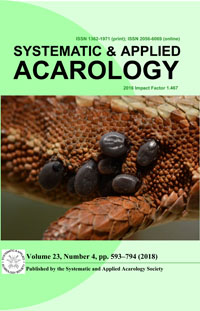The development, survival and reproduction of Stratiolaelaps scimitus (Acari: Laelapidae) were determined on four diets (Ephestia kuehniella eggs, Artemia sp. cysts, Typha orientalis pollen, and Tyrophagus curvipenis) in the laboratory at 25 ± 1°C, 80 ± 5% RH, 24 h D: 0 h L. E. kuehniella eggs and T. curvipenis were very suitable for the overall development of S. scimitus to adulthood, with over 90% survival rates. Shrimp cysts were not suitable, with 11.1% survival to adults, and T. orientalis pollen were intermediate, with 50% survival to adults. S. scimitus immature development was the fastest on T. curvipenis (9.67 ± 0.18 days), and it was also very fast on E. kuehniella eggs, but relatively slow on T. orientalis pollen (18.26 ± 0.68 days) and the slowest on Artemiacysts (21.36 ± 1.23 days). The female pre-ovipositional period (APOP) averaged less than 3 days on E. kuehniella eggs but over 3 days on T. curvipenis, but mated and unmated females had a similar APOP, regardless of diet. Neither diet nor mating had significant effects on the total pre-ovipositional period from birth to oviposition (around 13 days). The oviposition period averaged 1 to 2 days longer for mated females than unmated ones, regardless of diet, which had no significant effects. Mated females produced 50% more eggs than unmated females when feeding on E. kuehniella eggs, but 69% more than unmated females when feeding on T. curvipenis; the effects of mating were significant, and the effects of diet were different depending on mating status of the predators: fecundity was higher on E. kuehniella eggs (20.21 ± 1.16) than on T. curvipenis (17.07 ± 0.49) only for unmated females. Most life table parameters (intrinsic rate of population increase r, finite rate of population increase λ, and net reproductive rate R0) were not significantly affected by diet and mating. However, the mean generation time T was shorter in unmated females than in mated ones, and more so when feeding on T. curvipenis. T. curvipenis is easy to rear, so it is considered a very promising diet for S. scimitus as it does not damage plants nor cause allergenic reactions in workers or users. Since T. curvipenis is common on plants, future studies should explore the combined use of foliar predators (e.g. Phytoseiidae) and soil predators for the biocontrol of greenhouse pests (e.g. thrips) using a shared non-pest prey such as T. curvipenis.
How to translate text using browser tools
30 April 2018
Development, survival and reproduction of Stratiolaelaps scimitus (Acari: Laelapidae) on four diets
Lixia Xie,
Yi Yan,
Zhi-Qiang Zhang
ACCESS THE FULL ARTICLE
<
Previous Article
|

Systematic and Applied Acarology
Vol. 23 • No. 4
April 2018
Vol. 23 • No. 4
April 2018




